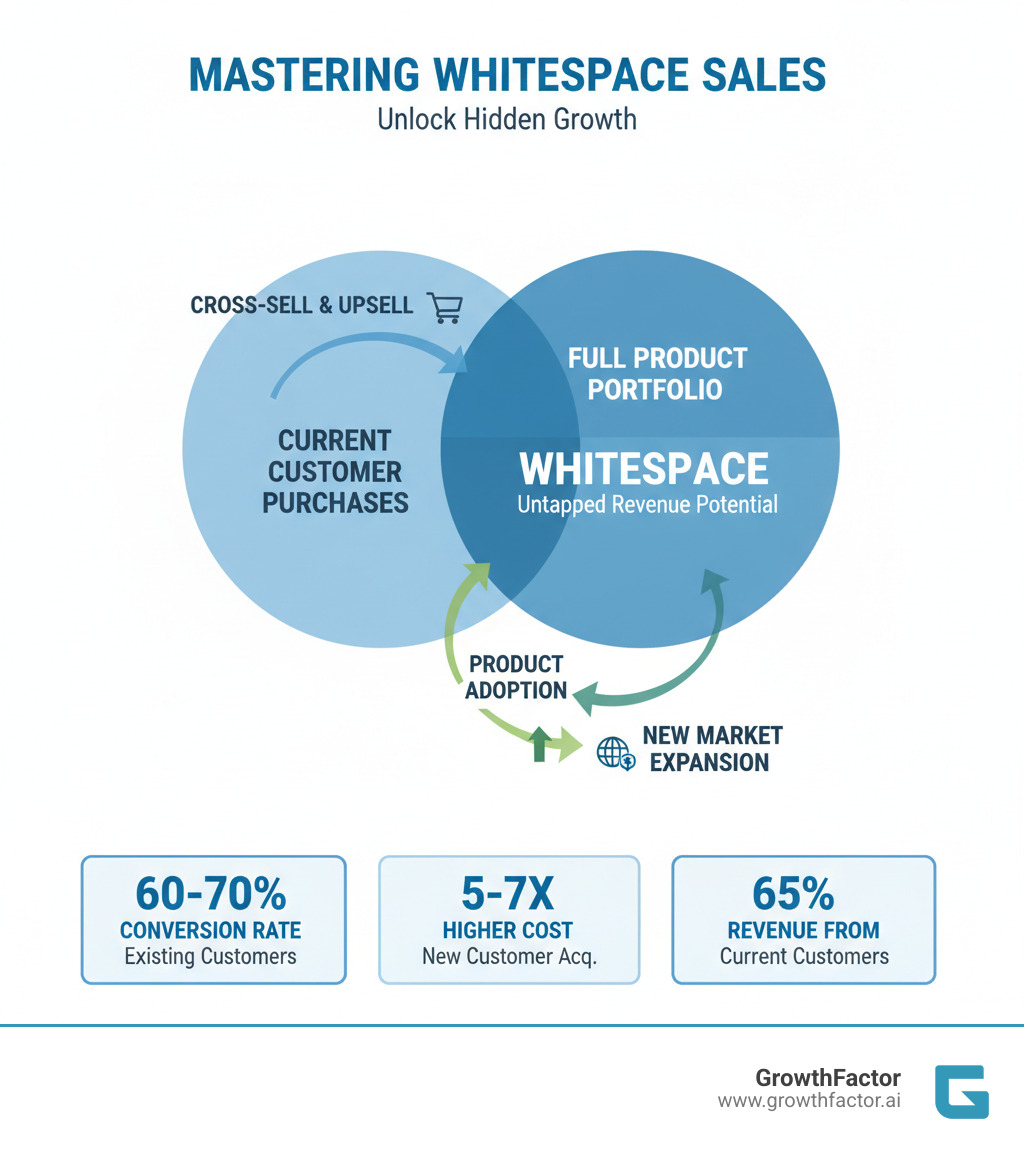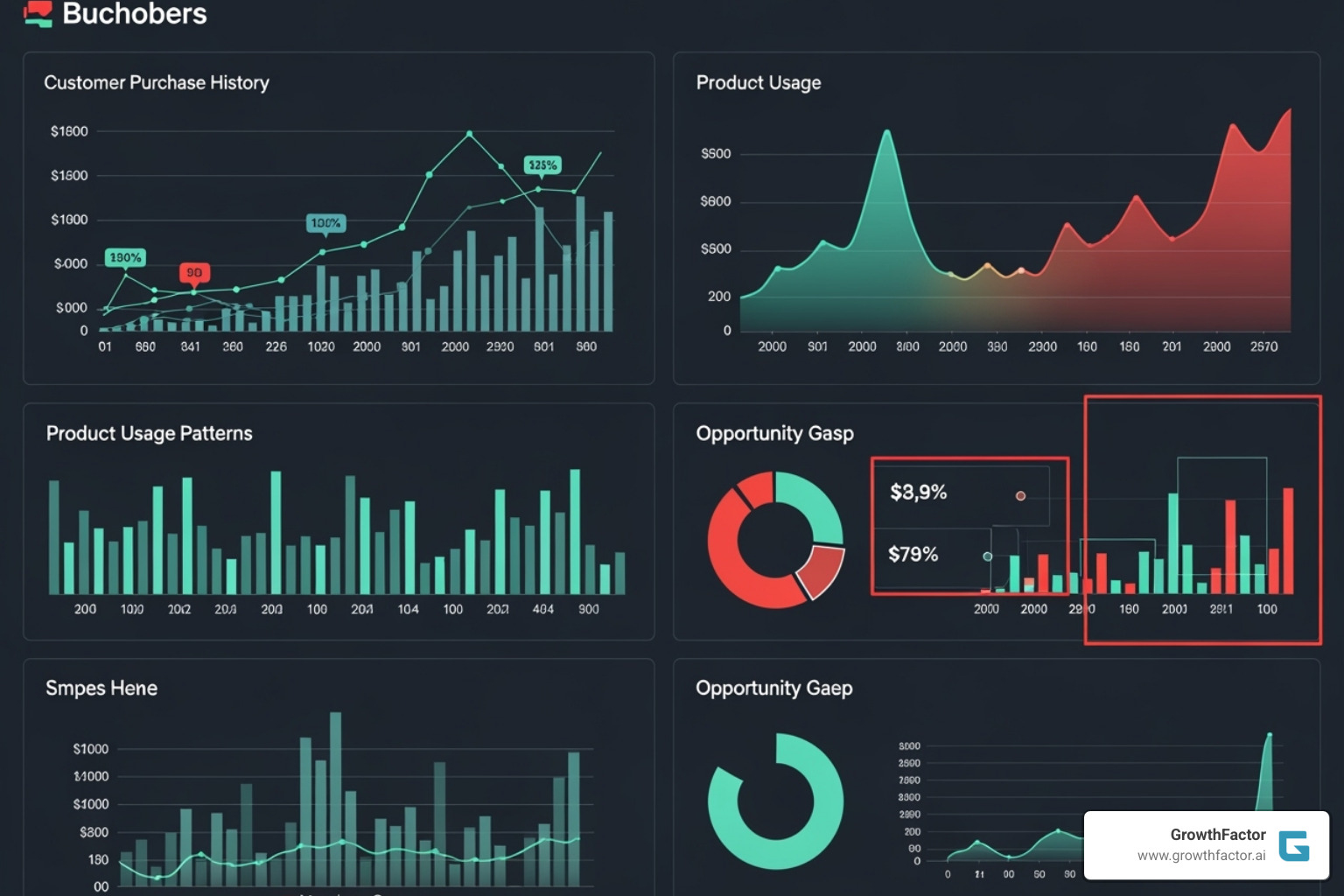Beyond the Margins: Mastering Whitespace for Sales Growth
Why Whitespace Sales is Your Fastest Path to Revenue Growth

Whitespace sales is the strategic process of finding and capturing untapped revenue opportunities within your existing customer accounts and market. Instead of the expensive grind of cold outreach—where it takes 18 calls to reach a single buyer with less than 1% conversion—whitespace focuses on the gaps between what your customers already buy and what else you could provide.
Key components of whitespace sales:
- Internal whitespace: Cross-selling and upselling to your current customer base (60-70% conversion rate vs. 5-20% for new customers).
- External whitespace: Untapped market segments or geographic regions where your solution fits unmet needs.
- Account landscape mapping: Visualizing which products each customer uses versus your full portfolio to spot gaps.
- Relationship intelligence: Leveraging existing connections instead of cold outreach.
The math is compelling: it costs 5-7 times more to acquire new customers than to grow revenue from existing ones, and 65% of a typical company's business comes from its current customers. Yet most sales teams obsess over new logos while ignoring the revenue hiding in plain sight.
I'm Clyde Christian Anderson, founder of GrowthFactor. With over a decade in retail operations and real estate, I've seen countless companies leave millions on the table by ignoring whitespace sales opportunities. We built GrowthFactor to make this analysis automatic and actionable.

What is Whitespace in Sales and Why is it a Growth Imperative?
Whitespace in sales refers to the untapped potential within your business, from unmet needs in your current customer base to new market segments you haven't explored. It represents the gap between what customers currently buy and everything else they could purchase from your portfolio. These aren't just empty spaces on a spreadsheet—they're low-cost revenue opportunities.
Capitalizing on whitespace deepens customer relationships and builds a competitive advantage. The numbers are clear: existing customers are 50% more likely to try new products and spend 31% more when they do. For retail real estate firms, this could mean spotting an underserved trade area for a new store or helping a successful tenant expand into another market you serve. This strategic approach is the foundation of Data-Driven Site Selection, turning guesswork into systematic opportunity. By focusing on whitespace, you recognize that the value of loyal customers is a pathway to predictable, profitable growth.
The High Cost of Ignoring Existing Customers
Most sales resources are poured into new customer acquisition, even though the probability of selling to an existing customer is 60-70%, versus less than 5% for a new prospect. This imbalance ignores the Pareto Principle (the 80/20 rule), where roughly 20% of your clients generate 80% of your revenue. Losing a single key account can be devastating.
Focusing on Customer Lifetime Value (CLV) brings this into focus. A customer who already trusts you is worth every future transaction you can create together. They have already cleared the highest hurdle: deciding you're worth doing business with. This built-in trust shortens sales cycles and changes the conversation from "convince me" to "show me what else you've got."

Internal vs. External Whitespace Mapping
Whitespace opportunities can be mapped in two directions: inward at current customers and outward at new markets.
Internal whitespace mapping is the fastest path to revenue. It involves examining your existing customer base to find upselling and cross-selling opportunities, increasing account penetration. For a retail real estate client, this could mean helping a tenant with three locations find sites for their next three.
External whitespace mapping focuses on new territory, such as new customer segments, underserved demographics, or geographic regions with strong potential. This is central to our Market Evaluation work, where we help brands identify prime expansion territories based on data, not gut feelings.
| Feature | Internal Whitespace Mapping | External Whitespace Mapping |
|---|---|---|
| Focus Area | Existing customer base, current accounts | New markets, new customer segments, competitive landscape |
| Primary Goal | Deepen relationships, increase share of wallet | Expand market reach, acquire new customer types |
| Strategies | Upselling, cross-selling, account penetration | Geographic expansion, product diversification, strategic partnerships |
| Data Sources | CRM data, purchase history, customer feedback, account mapping | Market research, competitive analysis, demographic data, industry trends |
| Risk Level | Generally lower (existing trust, known needs) | Generally higher (unknown variables, new challenges) |
The smartest growth strategies pursue both. By cultivating existing relationships while scouting new territory, you create a sustainable engine for profitable growth.
A Practical Guide to Identifying Whitespace Opportunities
Finding whitespace sales opportunities is a methodical, data-driven process. It involves detective work: analyzing CRM data, creating visual account maps, and conducting thorough market research to build a growth strategy backed by evidence. Our AI-Powered Retail Analytics transforms raw data into clear insights, showing you where to focus your energy.

Step 1: Internal Analysis of Your Customer Base
Start with the customers who already trust you. These relationships are your highest-probability, lowest-cost growth opportunities.
- Analyze purchase history: Look for logical gaps. If a retail brand uses your site selection platform, why not your deal tracking services? That gap is an opportunity.
- Segment your customers: Group clients by industry, size, or location to spot patterns. If similar customers have different product adoption rates, you've found a whitespace opportunity.
- Create an Account Landscape Matrix: Map your offerings against your client's buying centers (e.g., Real Estate, Finance, Operations). A blank cell where your Commercial Property CRM could serve their Finance team is a clear opening.
- Ask your customers: Use surveys and conversations to uncover their evolving challenges. Often, the best opportunities come from a customer saying, "I wish we could..."
Step 2: External Analysis of the Market
External analysis helps you spot new growth avenues and stay ahead of market shifts.
- Study competitor weaknesses: Identify customer needs they are ignoring or geographic regions they have overlooked. These gaps are your openings.
- Find underserved demographics and areas: Use demographic data to find populations or regions that lack adequate solutions. Our Retail Location Analysis Guide 2025: Trade Area Analysis Best Practices shows how to identify these opportunities.
- Monitor emerging trends: Early identification of trends, like the rise of conscious consumerism, can open massive new markets. Our Ultimate AI Market Analysis helps you stay ahead of these shifts.
Step 3: Leveraging Data and Technology for Finding Opportunities
Identifying whitespace opportunities at scale requires technology. The volume of customer, market, and behavioral data demands sophisticated tools.
Predictive analytics powered by AI forecasts what's likely to happen next, identifying which customers are likely to buy or which markets have the highest potential. Our AI Site Selection: Complete Guide shows how this turns data into recommendations.
Your technology stack should include:
- CRM Systems: The foundation for all customer data and interactions.
- Business Intelligence (BI) Platforms: To visualize data and reveal usage patterns.
- AI-Driven Analytics Tools: Platforms like GrowthFactor's Location Intelligence Software automate the analysis of vast datasets to find market gaps.
- Data Enrichment Tools: To augment your customer data with external information for a complete picture.
By integrating these technologies, you turn insights into action, giving your teams a clear roadmap to revenue.
Effective Strategies for Capitalizing on Whitespace Sales
Finding whitespace sales opportunities is the first step; turning those insights into revenue is where growth happens. This requires a combination of smart strategy, relationship building, and personalized outreach. At GrowthFactor, our Expert-Backed Retail Expansion services guide businesses through this entire process, from spotting the gap to closing the deal.

Exploiting Internal Whitespace: Upselling and Cross-Selling
Deepen relationships with existing customers through thoughtful upselling and cross-selling that solves their problems.
- Start with their problems, not your products. Ask about their challenges to naturally introduce relevant solutions. If a client struggles with lease management, introduce your AI-powered lease abstraction tools.
- Bundle complementary products. Package services that work together, like bundling location intelligence with deal tracking, to offer a more comprehensive and valuable solution.
- Offer premium upgrades. As a customer's needs grow, guide them to higher-tier offerings that support their next level of success, a common path for scaling Retail Brands.
- Map the customer journey. Anticipate how a client's needs will change as they grow and proactively introduce relevant services, positioning yourself as a strategic partner.
Leveraging Key Account Relationships for Whitespace Prospecting
Your most valuable accounts are networks of opportunity. Steer them thoughtfully to expand your reach.
- Map relationships: Visualize the org chart to see who you should be talking to. Understanding decision-makers and budget holders helps you bring value to more people.
- Find champions for warm introductions: Ask your existing contacts for an introduction to other departments. A warm intro to C-Suite Executives is far more effective than a cold call.
- Tailor your message: A CFO cares about ROI, while a VP of Operations focuses on efficiency. Customize your conversation for each stakeholder to provide relevant value. As noted in Gartner research on key account management, this client-centric approach improves retention and expansion.
Tapping into External Whitespace: New Markets and Segments
While internal whitespace offers quick wins, external whitespace drives transformative growth.
- Develop a market entry strategy: Before entering a new region or targeting a new segment, research local regulations, competition, and customer pain points. Our Market Entry Strategy guide details this process.
- Tailor your value proposition: Adapt your messaging and pricing to align with what a new audience values. What works for a national chain may not resonate with an emerging brand.
- Form strategic partnerships: Partner with local firms to gain instant credibility, market knowledge, and warm introductions, de-risking your expansion.
Overcoming Challenges and Measuring Success
Implementing a whitespace sales strategy has its challenges, but understanding them is the key to success. Tools like our Real Estate Deal Tracking Software help monitor progress and keep initiatives on track.
Common Challenges in Whitespace Exploration and How to Overcome Them
- Data Silos: Customer data is often scattered across departments. Solution: Use integrated technology to create a unified view of the customer and foster a culture of data sharing.
- Resistance to Change: Sales teams may be hesitant to adopt new processes. Solution: Secure strong leadership buy-in, provide comprehensive training, and showcase early wins to build momentum.
- Lack of Process: Without a clear methodology, efforts become inconsistent. Solution: Develop a standardized framework for analysis and execution, and consider a phased rollout to refine the process.
- Inaccurate Data: "Garbage in, garbage out" applies here. Flawed data leads to flawed insights. Solution: Implement regular data cleansing and enrichment, and enforce good data entry practices.
Tracking the ROI of Your Whitespace Sales Strategy
Measuring the ROI of your whitespace sales efforts is crucial for refining your strategy. Key metrics to track include:
- Account Penetration Rate: The percentage of your product portfolio adopted by each customer. A rising rate shows you're successfully deepening relationships.
- Revenue from New Offerings: The direct financial impact from cross-sells, upsells, and new market entries.
- Sales Cycle Length: Compare the time to close whitespace deals versus new logos. Whitespace deals should close faster, demonstrating improved efficiency.
- Customer Lifetime Value (CLV) Growth: A successful strategy increases the long-term value of each customer.
- Customer Satisfaction and Retention: Happy, loyal customers are more likely to expand their business with you and stick around.
Our Deal Dashboard consolidates these metrics, providing a real-time view of performance. This visibility transforms whitespace from a concept into a measurable, manageable growth engine.
Frequently Asked Questions about Whitespace Sales
What is the difference between whitespace analysis and simple sales reporting?
Simple sales reporting is a rearview mirror: it tells you what you've already sold. Whitespace analysis is a GPS for the future: it's forward-looking, using data to find potential revenue gaps. Reporting is about what was; whitespace analysis is about what could be. It proactively identifies untapped revenue.
How can a business with a small sales team implement a whitespace strategy?
A whitespace sales strategy is even more critical for small teams, as it maximizes the impact of every effort.
- Focus on your top 20% of customers where the potential return is highest.
- Manually analyze their purchase history against your product catalog to find obvious gaps. A simple spreadsheet is all you need to start.
- Talk to your customers. Use surveys and direct conversations to uncover their challenges and unmet needs.
- Use a simple CRM to log and track cross-sell and upsell opportunities. The goal is to start, learn, and iterate.
How often should a company perform a whitespace analysis?
A deep, comprehensive whitespace analysis should be done annually or semi-annually to align with strategic planning.
However, the identification and pursuit of opportunities should be ongoing. Sales teams should review their accounts for whitespace sales potential on a quarterly or even monthly basis. Customer needs and markets are not static. Treat whitespace analysis as a continuous discipline: find, engage, track, and repeat.
Conclusion: Turn Blank Spaces into Your Biggest Wins
Whitespace sales is a fundamental shift in your approach to growth. It's about working smarter by strategically mapping the opportunities that already exist within your reach, rather than constantly chasing new logos.
By focusing on both internal whitespace (cross-selling and upselling) and external whitespace (new markets and segments), you can build a more resilient and efficient business. The path is clear: analyze customer data, map your account landscape, and use AI-driven analytics to turn insights into action.
For businesses in retail real estate, where expansion decisions carry significant financial weight, this strategy is critical. An AI-enhanced platform like GrowthFactor automates the identification of geographic and portfolio whitespace sales opportunities. We turn complex market data into clear recommendations, enabling your team to move faster and with greater confidence.
A well-executed whitespace strategy creates a growth engine that runs on data and relationships. The question isn't whether to pursue it, but how quickly you can start. Those blank spaces on your growth map are filled with potential.
Ready to turn those blank spaces into your biggest wins? Discover how GrowthFactor's Market Evaluation services can map your next opportunity.
Citations
The human algorithm
Request a live demo
Schedule meeting
Or submit your information below and we'll be in touch to schedule.


